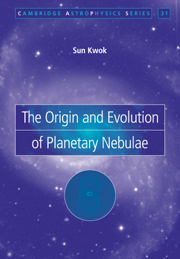Book contents
- Frontmatter
- Contents
- Preface
- 1 History and overview
- 2 Ionization structure of planetary nebulae
- 3 Nebular line radiation
- 4 Nebular continuum radiation
- 5 The neutral gas component
- 6 The dust component
- 7 Observations of the central star of planetary nebulae
- 8 Morphologies of planetary nebulae
- 9 Problems and questions
- 10 Asymptotic giant branch stars – progenitors of planetary nebulae
- 11 Evolution of the central stars
- 12 Formation of planetary nebulae
- 13 Dynamical evolution of planetary nebulae
- 14 Protoplanetary nebulae – the transition objects
- 15 Evolution to the white dwarf stage
- 16 Distances to planetary nebulae
- 17 Comparison between evolutionary models and observations
- 18 PN in the galactic context
- 19 Chemical abundances
- 20 Planetary nebulae in other galaxies
- 21 Concluding remarks
- References
- Appendix List of symbols and abbreviations
- Subject index
10 - Asymptotic giant branch stars – progenitors of planetary nebulae
Published online by Cambridge University Press: 04 November 2009
- Frontmatter
- Contents
- Preface
- 1 History and overview
- 2 Ionization structure of planetary nebulae
- 3 Nebular line radiation
- 4 Nebular continuum radiation
- 5 The neutral gas component
- 6 The dust component
- 7 Observations of the central star of planetary nebulae
- 8 Morphologies of planetary nebulae
- 9 Problems and questions
- 10 Asymptotic giant branch stars – progenitors of planetary nebulae
- 11 Evolution of the central stars
- 12 Formation of planetary nebulae
- 13 Dynamical evolution of planetary nebulae
- 14 Protoplanetary nebulae – the transition objects
- 15 Evolution to the white dwarf stage
- 16 Distances to planetary nebulae
- 17 Comparison between evolutionary models and observations
- 18 PN in the galactic context
- 19 Chemical abundances
- 20 Planetary nebulae in other galaxies
- 21 Concluding remarks
- References
- Appendix List of symbols and abbreviations
- Subject index
Summary
Stars are classified as low, intermediate, or high mass according to the nuclear reactions they undergo. Low-mass stars are defined as those that develop electron-degenerate He cores on the red giant branch (RGB). If the He core grows to ∽0.45 M⊙, the star will undergo a core He flash until degeneracy is removed and quiescent He burning begins. Intermediate-mass stars can initiate core He burning under nondegenerate conditions and develop an electron-degenerate carbon-oxygen (C-O) core after core He exhaustion. At the completion of core He burning, low-mass stars also develop an electron-degenerate C-O core, and their subsequent evolution is similar to that of intermediate-mass stars. This is the beginning of the asymptotic giant branch. Stars that are massive enough can undergo He-shell flashes (also called thermal pulses) on the AGB. The AGB is terminated by either (a) complete removal of the hydrogen envelope by mass loss; or (b) ignition of carbon in the degenerate core. Massive stars are defined as those that develop a nondegenerate C-O core and therefore can ignite carbon nonviolently. They are able to go through a series of nuclear burnings (C, O, Ne, etc.), leading to the construction of the iron core followed by core collapse and supernova explosion.
The end products of evolution for low-, intermediate-, and high-mass stars are very different.
- Type
- Chapter
- Information
- The Origin and Evolution of Planetary Nebulae , pp. 103 - 115Publisher: Cambridge University PressPrint publication year: 2000



